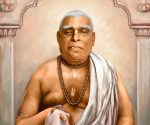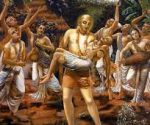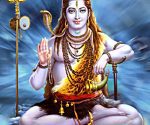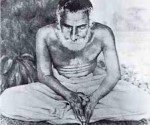Srila Madhvacarya’s Appearance Day
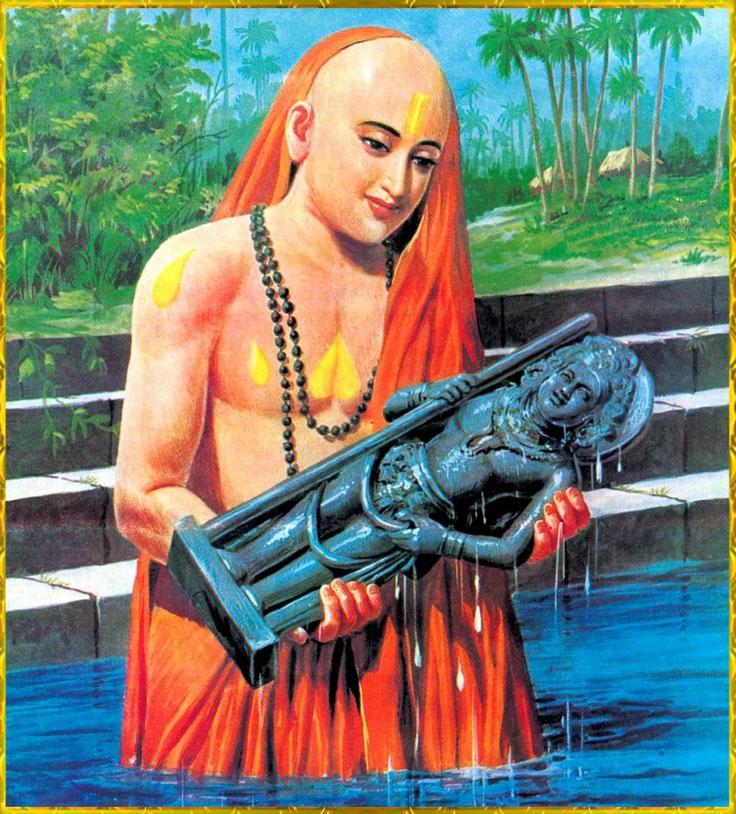 Sri Srimad Bhaktivedanta Narayana Gosvami Maharaja – Mathura, India, October 13, 2005
Sri Srimad Bhaktivedanta Narayana Gosvami Maharaja – Mathura, India, October 13, 2005
Today is the appearance day of Sri Madhvacarya, who is the sampradaya-acarya of our Brahma-Madhva-Gaudiya Vaisnava Sampradaya. He appeared in a place called Pajaka-ksetra. His father’s name was Madhvagaya, his mother’s name was Vedavidya, and his childhood name was Vasudeva. He took sannyasa at a very young age, and his sannyasa-name was Purna-prajna. His sannyasa-guru, who followed the mayavada philosophy of impersonalism, was named Sri Acyuta-preksa.
Madhavacarya took birth in Udupi, and his life was quite astonishing. He was an incarnation of Hanuman, Bhima, and Vayu – so he was very strong.
There was once a businessman who was trading in gopi-candana (tilaka). His boat became stuck in the mud and could not go forward. At that time Srila Madhvacarya had been bathing in the ocean, and he saw the big ship full of large pieces of gopi-candana there. He was approached by that businessman, and in order to assist him, he pushed the boat – by himself. He was so strong that the boat started moving, and he was offered a very big piece of candana as a gift, in appreciation.
In the meantime, while the boatmen were unloading the candana, that piece was broken, and a very beautiful deity of Krsna manifested from inside. That Deity’s name was of Bala-gopala – Dadhi-manthana Gopala. This Gopala Deity carries Mother Yasoda’s stick for churning yogurt.
He became very happy. Although the Deity was very heavy, he took the Deity on his shoulder, and, carrying Him to Udupi, he sang a song to Him that came spontaneously from his heart. In other words, as he walked the seven miles to Udupi, he composed the song called Dvadasa-stotra (Twelve Prayers). He carried the Deity there himself, composing many stavas and stutis (hymns and prayers) to Gopala, and after reaching Udupi, he established Gopal there.
Srila Madhvacarya wrote many books, and especially important are his three commentaries on Brahma-sutra – Brhad-bhasya and two Anubhasyas. In the Brhad-bhasya, he gave evidences for the presentation of his suddha-dvaita-vada philosophy. This philosophy states: Lord Sri Krsna, God, is the supreme eternal, the supreme living entity, the Supreme Self. The purpose of the entire yoga system is to concentrate the mind on this Supreme Self. We are not the Supreme Self. That should be understood. The Supreme Self is God. This is suddha-dvaita-vada – pure dualism. God is different from me. He is supreme and I am subordinate. He is great, and I am small. He is infinite and I am infinitesimal.
In his commentary, Srila Madhvacarya wrote his own composition in the form of Sanskrit verses, defeating the impersonal conception of Sri Sankaracarya.
All the Vaisnava sampradaya-acaryas, like Sri Ramanujacarya, Visnusvami and Nimbaditya, have contributed to defeating the theories of Sri Sankaracarya, and Srila Madhvacarya did this especially with his philosophy of suddha-dvaita-vada or bheda-vada (pure dualism).
The Srutis (Vedic scriptures) have described both principles: that the individual soul is the same as God and also that the soul is different from Him. In most cases, however, prominence has been given to the aspect of difference. In his writings, Srila Madhvacarya has described five differences: There is an eternal difference between God and the jiva (the infinitesimal living entity), God and maya (the Lords deluding, material potency), maya and the jiva, one jiva and another jiva, and one feature of maya and another feature of maya.
All the four bona fide sampradayas are Vaisnava-sampradayas. This means there is similarity in their goal and object of worship. They all worship Visnu-tattva (The Supreme Lord in His plenary manifestation). The followers of Sri Ramanujacarya-sampradaya worship Sri Laksmi-Narayana, and in the sampradaya of Srila Madhvacarya there is worship of Bala-gopala Krsna.
Srila Madhvacarya established four main Mathas (temples). In each of these Mathas there were two sannyasis, so in total there were eight sannyasis. These eight sannyasi acaryas practiced worshiping Lord Krsna in the mood of the gopis, but this worship was not given to the general population.
Sriman Mahaprabhu saw some lacking in the conception of Srila Madhvacarya, and He adjusted that. Sri Kavi Karnapura and Sri Baladeva Vidyabhusana have both declared that our Sampradaya-acarya is Srila Madhvacarya. In our disciplic succession we see that Srila Madhavendra Puri took initiation from Srila Laksmipati Tirtha in the Madhva-sampradaya. Therefore we have a connection with Sri Madhvacarya, although we are especially related with Srila Madhavendra Puri. Sri Advaita Acarya and Sri Nityananda Prabhu are related with Srila Madhavendra Puri, and Madhavendra Puri is related with Sri Madhvacarya.
Some people do not accept the position of Sri Madhvacarya – that he is our Sampradaya-acarya.*[See Endnote 2] Some sahajiyas and caste gosvamis cannot reconcile this. They say that Srila Baladeva Vidyabhusana was not in our sampradaya, because he was in the Madhva-sampradaya.*[See Endnote 3] But actually, our sampradaya is related to Srila Madhvacarya. Srila Bhaktivinoda Thakura has therefore said very strongly that those who do not accept Srila Baladeva Vidyabhusana or Srila Madhvacarya have no relation to pure bhakti. They are kali-chela, disciples of the personality of Kali-yuga .
We must understand all these established philosophical truths. Then we can understand who Srila Madhvacarya is, and what our relation with him is.
We are Vaisnava sannyasis. We have the sannyasa name “Bhaktivedanta”. I want that especially those who are in the renounced order, sannyasis, should learn and remember at least some of the sutras (aphorisms) of Vedanta. They should remember at least twenty-five sutras, together with their meaning and explanation. If you remember at least ten sutras of the Brahma-sutra, from the first one up to the tenth, you will find all philosophy there. In the Srimad-Bhagavatam’s four original verses, the entire Srimad-Bhagavatam is present, and this is also the case with Brahma-sutra; all the sutras are included in the first ten. You should surely remember them, otherwise you will be defeated by mayavada philosophers.
Gaura-premanande hari hari bol!




